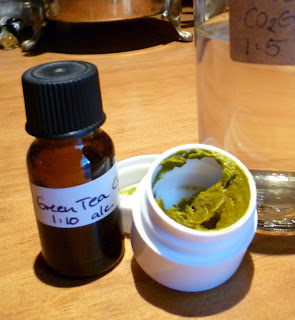Like most perfumers, I'm constantly searching for new and unusual ingredients to work with...
And one of my latest area of exploration is so called CO2's.
It is an extraction method that was first developed for the flavour industry, whereby carbon dioxide is used to extract concentrated materials from spices, fruits and nuts. In recent years it is also being used to create scent materials from flowers like jasmine.
Some perfumers are beginning to use them exclusively, instead of the more common absolutes, which use solvents such as hexane, believing that the method of extraction delivers a gentler and safer alternative.
Personally, I don't think this is necessarily true. Absolutes generally don't contain much, if any of the initial solvent, and these are not that toxic to start with.
What makes CO2's interesting to me, is that useing them gives me a far greater pallette to play with. I recently obtained a number of really interesting CO2's from a European company called Evonik, delightful things such as honey bush, jasmine tea and hazelnut! Totally yummy!
The only downside to them is that for some reason, they don't seem to have the same staying power as many absolutes, which is always a big problem in natural perfumery. I'm not sure why this is, but I have generally found this to often be true for Co2's.
The scent is also often softer, and they also don't seem to disolve very well in either alcohol or in oil.
You can get a wide variety of different forms of CO2 extract too...I have found everything from clear liquids to the solid green stuff you see in the photo, which is a nice green tea CO2 from White Lotus Aromatics.
There are also a lot of CO2's which simply don't work for perfumery. I got very excited when I first stumbled upon natural flavourings, but quicly discovered that many of the food CO2's have great flavours, but not much in the way of scent. Which makes them great as, well, flavours, but not perfume ingredients.
It is however a fascinating new area in natural extracts, and hopefully, companies will start producing more that are aimed at the perfumery market in years to come...(how about a violet flower CO2 eh? hint hint!!!)

I've learned that CO2 extractions work best for spices like cardamom, pepper, etc. There were a few, though, that oxidized after I diluted them in alcohol to make them workable (some CO2's include the waxy matter of the plant). Those included melissa, nutmeg and a jasmine extract. I didn't have much luck with my green tea CO2 either as it went moldy! However, there are some that I LOVE, like my Frankincense serrata CO2 from Eden Botanicals. I do agree, though, that CO2's don't have the same lasting power as absolutes.
ReplyDelete